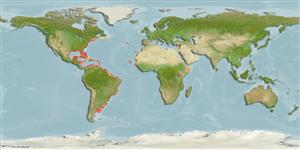Actinopterygii (ray-finned fishes) >
Perciformes (Perch-likes) >
Carangidae (Jacks and pompanos) > Caranginae
Etymology: Selene: Greek, selene = moon (Ref. 45335).
Environment / Climate / Range
Ecology
Marine; brackish; benthopelagic; depth range 0 - 55 m (Ref. 26912). Subtropical, preferred 25°C (Ref. 107945); 46°N - 45°S, 98°W - 16°W
Western Atlantic: Nova Scotia, Canada through most of the West Indies; along coasts of Gulf of Mexico and South America (Ref. 26938) to Mar del Plata, Argentina. Absent from the Bahamas (Ref. 26938). Replaced by Selene dorsalis in the eastern Atlantic. These two species have not been adequately studied and may prove to be conspecific. Known to occur in Mauritania (Ref. 5377).
Length at first maturity / Size / Weight / Age
Maturity: Lm 20.5 range ? - ? cm
Max length : 60.0 cm TL male/unsexed; (Ref. 26340); common length : 25.0 cm TL male/unsexed; (Ref. 5217); max. published weight: 4.6 kg (Ref. 26340)
Adults usually found near the bottom from inshore waters to at least 54 m depth, but may form schools near the surface (Ref. 5217). Juveniles are found on muddy bottoms brackish estuaries and in coastal marine waters (Ref. 5217). Adults feed on small fishes and crustaceans. Good food fish and marketed fresh.
Life cycle and mating behavior
Maturity | Reproduction | Spawning | Eggs | Fecundity | Larvae
Cervigón, F., 1993. Los peces marinos de Venezuela. Volume 2. Fundación Científica Los Roques, Caracas,Venezuela. 497 p. (Ref. 9626)
IUCN Red List Status (Ref. 115185)
CITES (Ref. 94142)
Not Evaluated
Threat to humans
Reports of ciguatera poisoning (Ref. 30911)
Human uses
Fisheries: highly commercial; aquarium: public aquariums
Tools
Special reports
Download XML
Internet sources
